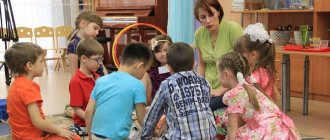Communication is of great importance in shaping a child’s personality. It is through him that the baby learns the world. Everyone around the child participates in communication. This is not only family and loved ones, but also kindergarten teachers. They also take an active part in the formation and development of the child’s character and personality, influencing his self-awareness, behavior, knowledge and skills. That is why the teacher’s pedagogical communication, his style and qualities, the teacher’s ability to “reach out” to the child, understand and accept his inner world are of great importance.
The effectiveness of pedagogical communication largely depends on how well the teacher can take into account the age and individual specific characteristics of children. After all, it will not be possible to communicate in the same way with a three-year-old and a six-year-old child. For the youngest, it is important to choose a tone and principles of address that will be close and understandable to him, but without unnecessary “lisping.” It is unacceptable to go to extremes here, because even with maximum closeness with the pupils, the teacher must still remain at a certain distance from the children, without becoming a temporary replacement for the mother. However, for children it is important to choose such methods and styles of communication in order to win over the child as much as possible and at the same time become an authority for him, a model of an adult.
For children of older preschool age, this style of communication is no longer suitable, and the teacher has to rebuild it based on the age characteristics of the pupils. At the same time, in communication with children, special warmth and kindness still occupy an important place, without which it is impossible to raise and educate children.
There are many different formulations and interpretations in the definition of pedagogical communication, but they all boil down to general concepts that give an idea of the phenomenon being described.
Direct and indirect impact
The following types of pedagogical influence are used when working with children:
- Direct pedagogical influence addressed directly to students regarding their behavior and relationships in the group. It includes the following methods of influence: instructions, explanations, rewards, punishments, and so on.
- Indirect pedagogical influence carried out through third parties. With it, the teacher does not directly issue instructions, but creates certain conditions that facilitate the children’s choice of the form of activity they desire.
For working with preschoolers, especially younger and middle-aged children, indirect pedagogical influence is most effective, since direct influence is often simply not perceived adequately due to the age of the pupils. At the same time, communication through games, reading fairy tales and fiction, and images of art achieves its goal much faster and more effectively.
The development of students is greatly influenced by the characteristics of the teacher’s pedagogical communication. If he manages to create the necessary atmosphere, win the love and trust of the pupils, training and education will be much more effective, softer and more delicate than when using authoritarian methods that suppress the child’s character and personality.
The culture of pedagogical communication of the teacher is equally important. If a teacher can cope with children solely with the help of authoritarian methods of influence, including shouting and punishment, he urgently needs to think about the reasons for what is happening and evaluate his own abilities and capabilities as a teacher. Perhaps the methods of influence he has chosen are the path of least resistance or simply the simplest way of communication, suppressing the personalities of children rather than nurturing them. By reviewing his actions, such a teacher will be able to find new, more rational and modern psychological and pedagogical foundations for communication between teachers and children.
Features and main problems of professional communication
Communication is one of the common categories described in philosophical, sociological, psychological and pedagogical literature. Since each of these sciences examines the phenomenon of communication from different positions, the meanings attached to the concept of “communication” may be different.
Even in modern psychology there are different views on the nature of the communication process. A number of scientists/psychologists (K. Osgurd and others) consider communication as an interindividual process that comes down to the exchange of information, the transfer of something to someone (for example, knowledge, social experience, etc.). In principle, communication here refers to the process of transmitting and receiving information.
According to another approach (M. Argyle, T. Shibutani, etc.), communication comes down to understanding, exchange of information and interaction, i.e. interactions. In the light of many domestic studies, it can be argued that only the categories “communication” and “interaction” are not fully suitable for the concept of “communication”.
The process of communication accompanies our entire lives; in everyday situations, a person actively enters into communication on one issue or another. However, communication situations can be divided into informational and goal-oriented. In the first, in accordance with the name, the main motive of communication is the exchange of information. This type of interaction includes, for example, situations such as conversations at a party, among friends or relatives, that is, such cases when a person can enjoy communication.
Unlike the first option, targeted communication is usually aimed at achieving a result, solving a problem. Most often, purposeful communication is associated with the performance of professional activities. Thus, we can conclude that professional communication is always goal-oriented. Goals, in turn, are determined by the nature and situations of professional activity. It is the achievement or failure to achieve goals that evaluates the degree of professionalism of the employee, his effectiveness, and the quality of performance of his official duties.
Based on this, professional communication is understood as the process of establishing and maintaining direct or indirect contact, determined by professionally significant goals that imply responsibility for their implementation, between an employee and a person involved in his professional interests.
In turn, direct contact implies direct communication between its participants (usually verbal communication).
And indirect interaction is called indirect contact (this is communication through writing, the use of means of communication, etc.).
In professional communication we can also distinguish between interpersonal and mass contacts. Interpersonal communication is more common because it involves direct contact between two or more people. Mass communication is a series of direct contacts between unknown and unknown representatives of a certain field of professional activity.
Professional communication is multifunctional in its content and purpose. In psychological terms, the following characteristics of professional communication are distinguished:
communicative: the goal is the exchange of information between its carriers;
interactive: the goal is interaction between participants in professional contact;
perceptual: we are talking about the perception of professional information.
Professional communication is possible between people who have a common level of knowledge. In the process of professional communication, a specialist acquires highly specialized knowledge, assimilates the norms and values that have developed in the profession, and adopts the experience of others.
Styles of pedagogical communication between educators and children
All available communication styles can be divided into the following types:
- Indifferent. With this type of communication, the teacher is not inclined to communicate with children, poorly achieves mutual understanding with them, is indifferent to them, evaluates their actions and achievements solely from the point of view of practicality and rationality, based on external signs, mainly on the quality of the children’s performance of routine moments. For him, the ideal ones are calm, obedient children who quickly obey orders without their own opinions or initiative. A teacher with this communication style is the least suitable for this type of activity.
- Game. Representatives of this type of communication pay a lot of attention to the play activities of children, prefer to conduct the learning process in a play style, and also evaluate the achievements of students based on how they manifest themselves in play communication, without, however, missing out on achievements in other areas of activity.
- Formal-pragmatic. Representatives of this group pay a lot of attention to the formal side of the educational and training process. For them, the exact fulfillment of instructions is of great importance, often without taking into account the age and individual characteristics of children. They show the same attitude towards the parents of their students. Because of their harsh, uncompromising behavior, such educators rarely win the love of their students.
- Didactic. The main activity of such educators is training. They pay the most attention to him, spending little time and effort on the emotional, artistic, and personal development of the child. They often achieve significant success in learning.
- Art. In their work, such educators pay special attention to indirect methods of pedagogical communication and concentrate on the artistic upbringing and education of children. As a result, students have the opportunity to demonstrate the artistic talents of their personality. They are revealed in visual arts, dance, singing, recitation, making crafts and so on.
To determine the quality of a teacher, a presentation of the features of the teacher’s pedagogical communication is used. The directors of the kindergarten and the head teacher in particular carry out a diagnosis of the style of pedagogical communication between the preschool teacher and children, helping to identify and correct existing errors and shortcomings in the work.
Forms of communication between children and adults
Communication between a child and an adult is vital for his development at any age. This process is most important in early childhood, before school, when his personality, character, and psyche are formed. Such communication can take different forms depending on the age of the baby. And the teacher needs to correlate the child’s age and his characteristic form of communication in order for this process to proceed effectively.
Situational-personal communication
Communication is not a need inherent in a baby at birth. At the very beginning of his life, he does not perceive the adults around him. But the parents, for their part, continue to talk to him, try to catch his brief glance, and attract special attention in every possible way.
The theme of the week is “Book Week” in the senior and preparatory groups
For your information! It is thanks to these actions of the parents that the baby, by the beginning of the second month of life, begins to realize the presence of an adult, and then respond to his actions.
An example is taken from an adult
Situational business form of communication between children and adults
First, communication is expressed in the form of the baby’s response to parental attention (communication begins): they talk to him, smile, look at him, in response the baby also smiles, moves his arms and legs.
Gradually, noticing a familiar person, the child begins to actively move, smile, walk, trying to attract attention. If he is deprived of attention, he begins to cry and scream. Once the need to communicate has arisen, it remains with the person until the end of his life.
Additional Information! Some parents carry out their parental responsibilities dryly, without unnecessary emotions, for fear of spoiling their child. Such upbringing is extremely harmful for an infant, since friendly, positive contacts between children and adults lay the foundations of the child’s personality, such as curiosity about the world around him, its perception, and self-confidence. If they are deprived of such communication, then children will grow up inactive, repressed or cruel and aggressive. You should not be afraid to spoil your baby; at this age there is no such thing as too much attention.
Extra-situational-cognitive form
According to psychology, this form of communication in a preschooler manifests itself in the period from 3 to 5 years. At this age, children have more opportunities. They become interested not only in the things themselves, but can also imagine their properties and functions, and determine their characteristics. Their speech is already developed enough to not only listen to explanations, but also actively participate in the conversation and ask questions.
Important! On the part of adults during this period, their reaction to the actions of children becomes important. Approval encourages the child to further understand the world, while criticism, on the contrary, becomes a barrier in communication, forcing the child to hide and move away from the adult.
Extra-situational-personal form
This is the final stage in the evolution of forms of communication between preschoolers and adults. The main difference between this form of communication and the previous stage is that it aims at the social aspect of relationships between people, and not the material nature of things. This function is called “pure” communication.
Children of senior preschool age already exhibit personal motives that encourage children to communicate. They can manifest themselves in the process of various activities: work, play, education, sports. But now it has its own meaning.
For preschoolers, communication of this kind is important, since through it they learn the essence of the social structure of people’s society, the motives of their actions in relation to certain circumstances. An adult serves as a source of information about social phenomena in society.
For your information! A child chooses an adult as his role model, because he has not had such experience before - every situation is new for him, and he needs a standard, a means of achieving a goal, which he will look up to and build upon in later life, when the adult is not around. Therefore, for the further successful development of the baby, it is important what examples of behavior he will encounter for the first time.
Types of thinking in preschool children




